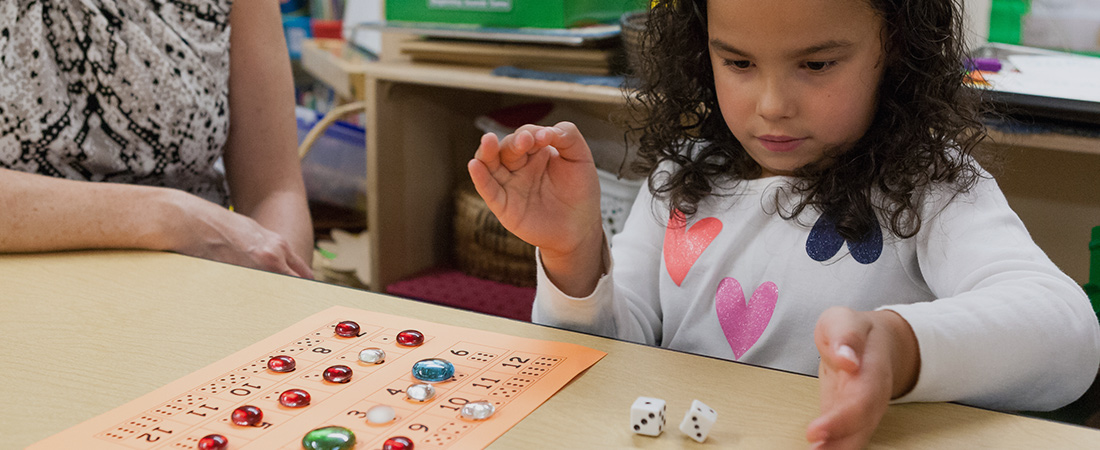5 Ways to Help Preschoolers Persist in Mathematics

Two preschoolers are sitting side by side trying to solve the same math task. Both get stuck. But while one gives up, the other tries different approaches until she gets to an answer. She is demonstrating “mastery motivation”—the willingness to struggle through tough problems.
As preschool teachers know, not all children have the same inclination to persist when challenged. But that’s ok, says EDC’s Jess Young, because this mastery orientation can be developed.
“Early childhood teachers are in a great position to encourage children to persist at challenging tasks,” she says. “Preschoolers are natural problem solvers. Sometimes they just need a little bit of support.”
Along with EDC’s Young Mathematicians team of Paul Goldenberg and Kristen Reed, Young has been studying mastery motivation and its relation to early mathematics development in preschool classrooms. Here, Young and Goldenberg present five things that all parents and teachers can do to foster this essential skill.”
1. Play math games with your child
Young recommends teachers and parents start with puzzles and games, including math games. Fun, simple games like Jumping on the Lily Pads and Two Numbers help students build basic ideas about number and order along with mathematical habits of mind, such as problem solving, puzzling, and perseverance. Research also shows that children’s mastery motivation is related to their mathematics knowledge.
“Math games encourage children to problem-solve,” says Young. “Games also allow children to try different strategies without the fear of failure, because there is usually more than one way to win.”
In fact, working through difficulty is part of what makes games enjoyable, says Goldenberg.
“There’s no joy in playing a game that’s too easy,” he says. “The right game for a child is one that is easy enough to play yet just hard enough to be fun.”
2. Ask them open-ended questions
While it may be tempting to provide an answer to a child who is stuck, Young says it is more effective to ask them questions. The more open-ended, the better.
“Ask, what can you do next? and where do you think that piece goes? Or ask the child to show you how he did something,” says Young. “These types of prompts help the child develop problem-solving strategies and a sense of competence, which is key to mastery motivation.”
When asking open-ended questions does not re-engage the child, it is okay to give just enough information—and some gentle guidance—to get past the point of frustration. A well-timed, “I wonder what would happen if you turned this…” or even just holding the puzzle board steady so they can add their piece may be enough. Then step back and let the child continue to work.
3. Support their independence
Children who exhibit mastery motivation are able to stick with a task when it gets difficult. Perhaps that is because persistence and autonomy are related says Goldenberg.
“If I figure I am really in control, and I have a chance at solving this puzzle, then I’ll put effort into it,” he says. “But if I’ve hit the limit, then I’ll put my effort somewhere else.”
Young says that teachers and parents can support this persistence by letting children work independently on activities, games, and projects that interest them. And she encourages teachers and parents to resist the urge to intervene too quickly if things get difficult.
“If you jump in, you are taking the challenge away from the child, and they don’t develop that sense that they can solve something hard,” says Young.
Young recalls one time when her son was struggling to solve a puzzle. Frustrated, he threw a puzzle piece across the room. Then, a few moments later, he calmly picked it up and tried again. He soon made it fit.
“I really wanted to jump in and help him,” she recalls. “But if I had, he might not have kept trying or seen himself as capable of solving the puzzle. Learning that you can still solve a problem even when you feel frustrated is a big part of developing mastery motivation.”
4. Recognize the value of repetition
When children are offered opportunities to learn that have more than one solution, such as puzzles or math games, they will play that game repeatedly. Think of a child who does the same puzzle over and over. Or a child who uses the same set of wooden blocks to build increasingly intricate buildings. While these experiences may look repetitive to adults, Goldenberg says that they play a critical developmental role.
“When children repeat something spontaneously, it is generally because they are still gaining something from that experience,” he says. “And when they are no longer learning from it, that repetition is no longer interesting to them and they move on.”
He notes that repetition is a valuable developmental strategy that young children use to learn new things. But there is a difference between choosing to repeat a game or puzzle because it is enjoyable, and forced repetition—for example, repetition of math facts to build fluency.
“The former leads to mastery motivation; the latter just leads to mastery of facts,” says Goldenberg.
5. Show appreciation for their efforts
When children do persist through difficulty to reach a solution, it is only natural to want to offer some praise. But it is better to comment on the child’s effort, rather than praising the child herself says Young.
How do you do this in practice? Say, “Wow! You worked really hard on this puzzle. You stuck with and you solved it!” instead of “Wow, you are great at puzzles!”
“When you appreciate effort, children learn that working hard and persisting is a positive thing,” she says. “That becomes really important as children grow, and they are faced with more and more difficult problems. They need to know that it’s okay to struggle, that it’s part of the learning process.”
